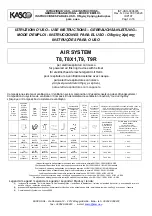
3. Do not use when concentrations of contaminants are unknown or
immediately dangerous to life or health (IDLH).
4. Leave area immediately if:
A. Breathing becomes difficult.
B. Dizziness or other distress occurs.
C. You taste or smell contaminant.
D. You experience eye, nose or throat irritation.
5. Use strictly in accordance with instructions, labels, and limitations
pertaining to this device.
6. This respirator may not provide a satisfactory seal with certain facial
characteristics, such as beards or large sideburns, that prevent direct
contact between the skin and the sealing surface of the face-piece. Do
not use this respirator if such conditions exist.
7. Never alter or modify this device.
8. This respirator is for use by trained, qualified personnel only.
9. The respirator may not adequately protected against propelled or falling
objects. Consequently, in riot or similar situations, it is imperative that a
proper faceshield be worn in conjunction with the respirator for protec-
tion.
Failure to follow the above warnings can result in serious personal injury
or death.
RESPIRATOR USE LIMITATIONS
The wearer must comply with the following respirator use limitations:
1. MAXIMUM USE CONCENTRATION - Do not exceed maximum use con-
centrations established by regulatory standards.
2. The limitations outlined in the applicable NIOSH approval.
3. For respirators with class P filters: Replace filters when excessive breath-
ing resistance occurs while inhaling.
4. For respirators with chemical canisters:
a. Users must follow an appropriate canister change-out schedule devel-
oped by a qualified professional. The change-out schedule must take
into account all factors that may influence respiratory protection includ-
ing specific work practices and other conditions unique to the work
environment. Canisters equipped with an end-of-service-life indicator
for a specific contaminant present must be replaced when the indicator
changes to the specified color or sooner if using the respirator against
a mixture and the canister change-out schedule specifies an earlier
replacement.
b. If using the respirator against substances having poor warning proper-
ties, over exposure can occur without user awareness. Take appropriate
precautions to prevent over exposure, which may include an earlier can-
ister change-out, or using an air-supplied respirator or SCBA. For further
information refer to MSA’s Response Respirator Selector.
c. Replace canisters every shift or sooner, if indicated by change-out
schedule or end-of-life indicator. Use beyond one shift could result in
shorter than expected service time and over exposure due to contami-
nant desorption and migration through the canister when not in use. If
using the respirator for escape, replace canisters after each escape.
TAL 8001 (L) Rev. 10 - 814175
3
Содержание advantage 1000
Страница 11: ...TAL 8001 L Rev 10 814175 11...
Страница 12: ...12 TAL 8001 L Rev 10 814175...




















